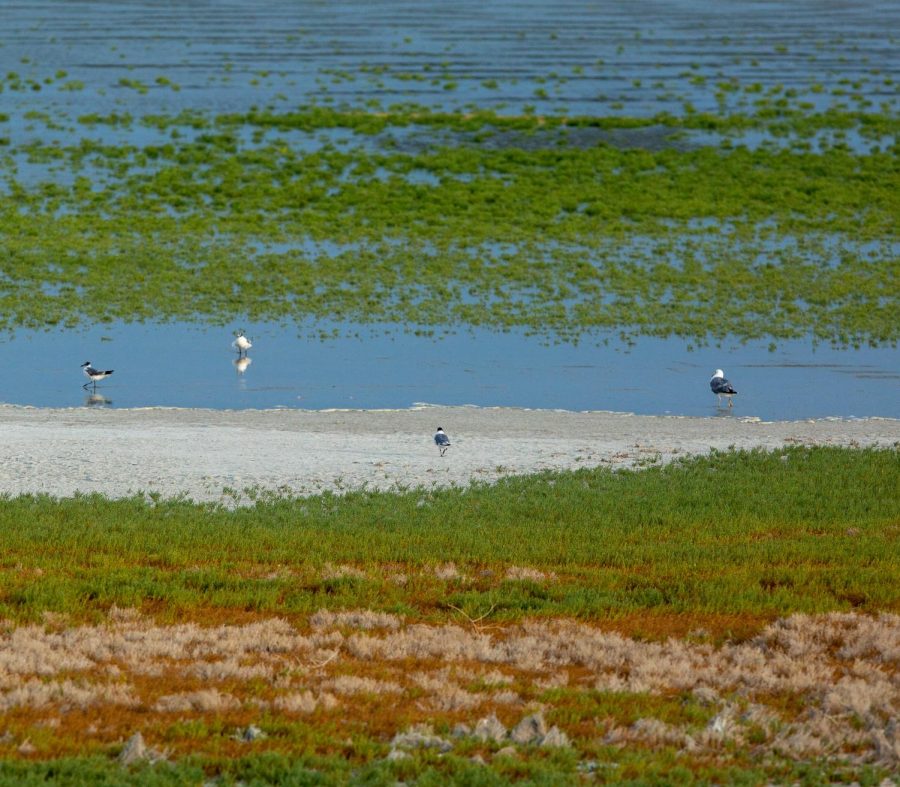Cowley: The Drought Isn’t Over
California Gulls and Black-Necked Stilts wade in shallow water on the east shores of the Great Salt Lake in Syracuse, Utah on July 27, 2021. (Photo by Gwen Christopherson | The Daily Utah Chronicle)
March 25, 2023
As part of the research done for a Can of Worms episode, our podcast team took a trip down to Antelope Island to visit the Great Salt Lake. As we drove in, the entire area looked incredibly grim. We passed dried up docks and lots of cracked lakebeds. When we stopped at a lake access point, we had to walk 10 minutes before we could catch a glimpse of any water.
For the first time since I moved here, Utah has received a substantial amount of snowfall in both the mountains and valley. Last year, I remember only seeing one or two inches on the ground even though I lived further up on campus. This year, on multiple occasions, it’s taken me 30 minutes to dig my car out from underneath a mountain of snow. One particularly bad winter storm even moved classes online for a day.
At first glance, the amount of water the valley received this winter looks promising. However, much of the state remains in desperate need of more moisture. Drought remains a pressing issue in Utah and should be treated as such.
We’re Still in a Drought!
Unfortunately, one good year of snow and rain doesn’t undo the damage of two decades of drought. About 48.7% of Utah remains in severe drought, even after a winter of heavy snowfall. Utah’s lakes are desperate for more water. Lake Powell and the Great Salt Lake remain at alarmingly low levels from the years of drought. Even with the new snowfall, the Great Salt Lake grew less than one foot in size.
The dry conditions on the west coast have taken a toll on the environment and people alike. If the Great Salt Lake continues to dry out, the sediment from the bottom of the lake could create toxic dust, making the valley uninhabitable. The lake shrinking will also devastate ecosystems, as many migrating birds take refuge at the Great Salt Lake. If Lake Powell’s water levels continue to drop, the lake will no longer be functional as a source of hydropower, depriving many in the region of power. The lack of water in Utah continues to affect the future of the state, regardless of one good winter.
A New Normal for Winter
The future of Utah winters is uncertain. It’s impossible to tell at this point if the winter we experienced this year will continue in trend. Winter storms in Utah are incredibly hit or miss. Some years are dry, others hit the valley with storm after storm. Just because this year yielded a good snowpack does not mean the following year will follow suit.
Even with a good winter, the summer months play a large role in how scarce the water supply becomes. For multiple years now, Utah summers produce sweltering and dry conditions. Utah temperatures reached record-breaking highs throughout the past summer. Extreme temperatures make drought conditions harder to control and predict, making it even harder to predict what impact this winter will have.
What We Can Do
Hoping that the pattern of snowfall and rain will continue is not enough. Utah needs to start making drastic changes in the ways it handles drought. While some reform made its way through the legislative session this year, it isn’t nearly enough to save Utah’s lakes. Most of Utah’s water still goes towards agriculture, consuming 63% of the water in the Great Salt Lake Basin. One program in Utah gives farmers an opportunity to lease their water back into the lake, but it has been a hard sell. At this point, the program needs to improve incentives and education to get people to sign on.
We also need to drastically reduce urban water use. Traditional landscaping is not meant for a desert climate, yet 60% of residential water use in Utah goes towards lawn care. Implementing more drought-resistant landscaping would not only cut down on the amount of water needed for residential use, but would also bring more water into the lakes that desperately need it.
One year of good snow and rain is not nearly enough to undo the damage of the last 20 years of drought. Our troubles are far from over. It is as important as ever to push for water conservation and water legislation reform to ensure that our state remains habitable for years to come.








